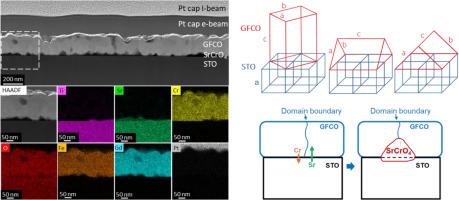A transmission electron microscopy study of orientation relationships and interfacial reaction products in GdFe0.5Cr0.5O3 films grown on (001) SrTiO3 substrates by solution synthesis
IF 2
4区 材料科学
Q3 MATERIALS SCIENCE, COATINGS & FILMS
引用次数: 0
Abstract
GdFe₀.₅Cr₀.₅O₃ (GFCO) is a single-phase magnetoelectric multiferroic at temperatures close to ambient. Epitaxial thin films of this orthorhombic perovskite would offer the possibility of tuning its electrical and magnetic properties through control of strain and interface effects. Here, 200 nm thick GFCO thin films have been grown on (001) SrTiO3 substrates by solution synthesis and the microstructures have been investigated by cross-sectional transmission electron microscopy. The GFCO films are epitaxial but exhibit a mixture of three different orientation relationships in the form of domains ≈50 nm in diameter. Geometric analyses of the lattice matching show that the misfits for these domains would be tensile with magnitudes of less than 2 %. Pockets of a SrCrO4 reaction product form at the film/substrate interface and do not exhibit any simple orientation with the adjacent phases. The product morphology indicates that the outward diffusion of Sr is more rapid than the inward diffusion of Cr, and this is related to the microstructures of the surrounding phases. These data show that epitaxial films of GFCO can be obtained via this route, but careful control of process parameters would be required to produce single-domain films, and alternate substrates or buffer layers would be needed to inhibit SrCrO4 formation.

溶液合成法在(001)SrTiO3衬底上生长GdFe0.5Cr0.5O3薄膜的取向关系和界面反应产物的透射电镜研究
GdFe₀₅Cr₀。₅O₃(GFCO)是一种单相磁电多铁质材料,温度接近环境温度。这种正交钙钛矿的外延薄膜将提供通过控制应变和界面效应来调整其电学和磁性能的可能性。本文采用溶液合成的方法在(001)SrTiO3衬底上生长了200 nm厚的GFCO薄膜,并用透射电镜对其微观结构进行了研究。GFCO薄膜是外延的,但表现出三种不同取向关系的混合物,其形式为直径≈50 nm的畴。晶格匹配的几何分析表明,这些区域的不匹配将产生小于2%的拉伸。srcr4反应产物的口袋形成于薄膜/衬底界面,与相邻相不表现出任何简单的取向。产物形貌表明,Sr向外扩散的速度比Cr向内扩散的速度快,这与周围相的显微组织有关。这些数据表明,GFCO的外延薄膜可以通过这种途径获得,但需要仔细控制工艺参数以产生单畴薄膜,并且需要替代衬底或缓冲层来抑制SrCrO4的形成。
本文章由计算机程序翻译,如有差异,请以英文原文为准。
求助全文
约1分钟内获得全文
求助全文
来源期刊

Thin Solid Films
工程技术-材料科学:膜
CiteScore
4.00
自引率
4.80%
发文量
381
审稿时长
7.5 months
期刊介绍:
Thin Solid Films is an international journal which serves scientists and engineers working in the fields of thin-film synthesis, characterization, and applications. The field of thin films, which can be defined as the confluence of materials science, surface science, and applied physics, has become an identifiable unified discipline of scientific endeavor.
 求助内容:
求助内容: 应助结果提醒方式:
应助结果提醒方式:


